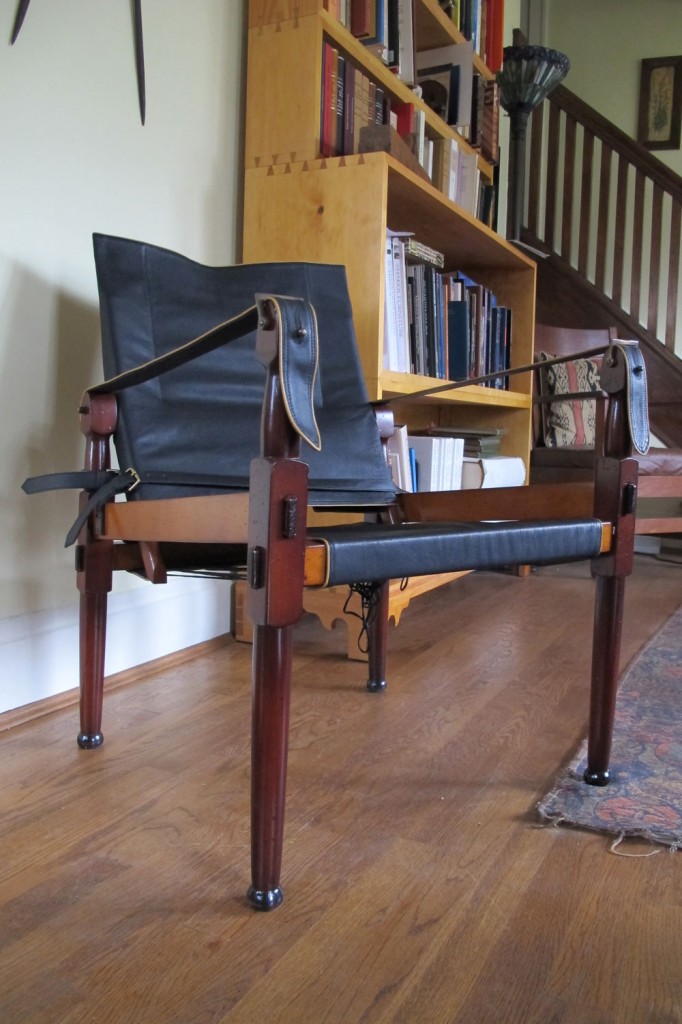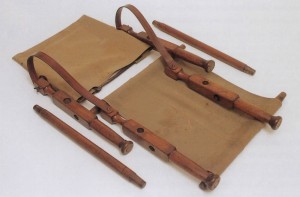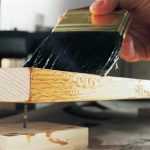We may receive a commission when you use our affiliate links. However, this does not impact our recommendations.
I’m gearing up to build a run of Roorkhee Chairs for some customers and (fingers crossed) this magazine. But before I can even order the wood I had to do something I thought I’d never do again: Buy a piece of commercial furniture.
 The Roorkhee Chair is a seminal piece of British campaign furniture and was popular with British officers from 1898 to World War I, according to Nicholas Brawer’s book on campaign furniture. Named in honor of the headquarters of the Indian Army Corps of Engineers in Roorkhee, India, the chair is lightweight at about 10 lbs., breaks down quickly and is allegedly quite comfortable.
The Roorkhee Chair is a seminal piece of British campaign furniture and was popular with British officers from 1898 to World War I, according to Nicholas Brawer’s book on campaign furniture. Named in honor of the headquarters of the Indian Army Corps of Engineers in Roorkhee, India, the chair is lightweight at about 10 lbs., breaks down quickly and is allegedly quite comfortable.
The Roorkhee Chair influenced several modernists’ designs, including Marcel Breuer, Le Corbusier and Kaare Klint.
I’m attracted to the chair’s simplicity of construction – it can be made with a lathe and a drill press – and its good looks. I’ve never been on a safari, but I think this is the chair I’d bring along.
After looking at photographs of several dozen chairs I discovered a lot of variability in the way the seat sloped and the height of the arms. After building a fair number of chairs, I can also tell you that building a chair from a photograph is asking for a black eye – or a sore bottom.
So I decided to purchase a commercial chair as a starting point for my design. I also wanted to get a close look at the way the upholstery was sewn and strung because I need to get my head wrapped around that system as well.
So I ordered an inexpensive Roorkhee copy and it arrived in the mail today. When I saw it in the catalog there were lots of things I didn’t like about it. The turnings weren’t crisp or in the same shape as historical examples and the upholstery is black leather (I plan to do canvas). But the seat angles looked right to me compared to some other commercial versions.
The chair arrived in a lightweight box this morning and I spent several hours assembling it and taking notes.
The assembly part was amusing. The original chair breaks down into four legs, four stretchers and a back piece. And all the joinery is through-tenons. Not so with this chair. Though it looks like it knocks down like the old chairs, it doesn’t. The stretchers on the side of the chair are glued into the front and back legs. Strike 1.
The wood is some nameless tropical that is dyed to look like mahogany. Plus they have added a bunch of fake worm holes and glazed or toned the feet to make it look aged. They didn’t do a terrible job, but the end effect makes it look fake to anyone who has seen real worm holes and dirty legs. Strike 2.
After lacing and unlacing the corset that controls the seat about five times, I concluded that I never want to be a dominatrix. I eventually got the seat so it was tight on the chair, yet yielding. A simple slip knot (glad I’m not a sailor, too) held the lacing in place.
Then came time to sit in it; I wasn’t expecting much.
It was shockingly comfortable. It might even be more comfortable than my Morris chair – I’ll need to do some side-by-side buttock comparison testing. So I spent the next hour or so measuring the chair and picking apart the elements that make the chair so sitable.
First detail: The front rail of the seat is low at 15”. Most chairs I make, even for lounging, are slightly taller than that. Second detail: The back rail is only 12” off the ground. That means the seat drops 3” from front to back, which is quite a lot.
Add to that a deep seat at 18”, the fact that the arms are a perfect 9” above the seat (and slanted as well), and the clever tilting back and I now understand what makes this chair tick.
I am now ready to draw my own version of the chair, which will be based closely on historical examples, unlike this commercial chair. But I do begrudgingly acknowledge that the designer of this commercial chair really got the numbers right.
— Christopher Schwarz
If you like chairs, I recommend the book “500 Chairs” as a source of inspiration, particularly with modern forms. You can read more about this book in ShopWoodworking.
Here are some supplies and tools we find essential in our everyday work around the shop. We may receive a commission from sales referred by our links; however, we have carefully selected these products for their usefulness and quality.












I’ve been trying to find this design for years, ever since I purchased a set of chairs secondhand from a coworker in 1993.
The set I have is slightly different in design – all of the pieces are round, and the location of the through mortises isn’t extra beefy as in this photo. This resulted in both chairs breaking at the the back through mortise. I have yet to make replacements, I haven’t even begun to scratch the surface of woodworking and wood turning is far down my to do list. I’ll try to dig them up, assemble them and upload some photographs.
There are some other design differences in the chairs I bought:
The legs are stabilized by a second set of front-to-back stretchers.
The leather straps of the arms and that serve as the bottom rail of he back are secured to brass fittings that are bolted through the arms and upper stretchers.
My chairs came with leather cushions, probably because of the concerns about the front cutting into the legs. I’ve used various camp chairs and I know from personal experience the discomfort the commenter mentioned, but I didn’t find that much of an issue with my chairs on the occasions when the leather cushions were left off. If I had to guess, I’d say that’s because of a combination of three factors:
1) The rail at the front edge of the seat is a 1.5 round dowel.
2) The leather seat wraps around that dowel and is laced pretty tightly.
3) The low height of the seat and the sharp backward angle tends to put less of your weight on the front edge.
The leather components of my chairs are about 8 to 10 ounce weight (again, when I have time to dig it up I’ll also try to find my leather gauge and get a more accurate thickness). It’s not vegetable tanned, although good veg tan would hold up pretty well for this purpose if properly treated. It’s probably latigo, which is a pretty tough leather and suitable for outdoor use.
I’ve always wanted to make more of these chairs for camping. If I ever manage to do so, I’ve considered figuring out some way to waterproof the feet – perhaps with brass or copper. I usually have them under some sort of rain fly, but damp or even muddy ground seems inescapable.
Here is another style campaign chair
It would be great to see it Schwarzitized
http://www.britishcampaignfurniture.com/products?id=29034
I’ll go with the minority opinion here – that chair is uglier than a mud fence (both the newly-manufactured one and the vintage ones I could find pictures of on-line).
One comment about comfort, though – as a veteran of many camping trips, I can tell you that just about any folding chair that has a rail across the front and no rigid structure under the seat is comfortable for 15 or 20 minutes, and then’s downright painful. A considerable improvement is to place a removable “X” under the seat to hold the chair’s stretchers apart.
Thanks. I guessed it might have been featured previously.
Never mind the chair, that’s a great looking bookcase in the background. Can you tell us (me) more about it? Thanks.
Chris, as soon as I see your plans, I’m gonna make some of these. I need to make knock down furniture of all sorts. Tables, chairs, desks, etc. Any other plans, I’d sure like to see them.
I remember reading about wood that has been kiln heated which makes it resistent to insects and rot making it ideal for outdoor applications. I haven’t found it locally here in the mountains, and am not sure where it might be sold. The drying process makes the wood lightweight but there are some downsides in that splitting might be more of a concern. The author recommended predrilling holes for screws/nails. Sounds like this might be a viable option for you Chris, as you could probably use a wood that in it’s dry form would be too heavy untreated. Another selling point for this wood is it’s light weight as treated wood for outdoor projects having been soaked in chemicals is quite heavy and not always friendly to the earth. Looking forward to hearing more about your progress, and would make a great feature for the magazine.
I’m a veteran of six photo-safaris in East Africa and a big fan of campaign chairs.
I have a pair of vintage Kaare Klint campaign chairs, canvas and mystery wood painted black, that I found in an antiques mall in Florence, KY. I paid $45 for the pair.
I look forward to reading more about your project.
Just don’t try making these with pawpaw wood. 🙂
This chair is beautiful!
PopWood’s primary focus is on traditional American forms. I’d love to see more projects that are unconventional like this campaign chair. Perhaps some European forms like Jugenstil and forms from the 1920s on.
I used to make a lot of campaign chairs back in the late 80’s – mid 90’s. Of the 10 wooden components, 8 were turned. All rails were the same and all legs were the same, so it was great for production turning in small runs. I devised a way to drill the tapered round mortises to suit the tapered round tenons, and each chair had two “left hand legs” and two “right hand legs” in the way the mortices were drilled. Sales increased markedly when I replaced the canvas components with heavy leather. Awesome. I still have a soft spot for these indestructible and versatile chairs. I’ve sent you an email with more detail, Chris.
Enjoy your explorations.
Cheers,
Greg, Western Australia.
http://www.gregdmiller.blogspot.com
I’m not crazy about the look of this purchased one but can’t wait to see your take on it Chris. Tell Megan that we all want to see it in the magazine as soon as possible!
I think I speak for everyone, everywhere, that I too am glad that you never want to be a dominatrix. 😉
I’m the naysayer of the bunch, I guess. The chair looks butt ugly to me. However, I’ll bet good money that it is comfortable. Many years ago in the Marine Corps I worked with a Top (Master Gunnery Sergeant) that took something very much like this to the field. I don’t remember/don’t know where he got it from. But that sucker was comfy.
Very cool chair. If that makes it into the Magazine I might just need to finally break down and buy a lathe, figure out how to use it….and find a seamstress.
It looks like a fun project to build. Kind of like an upscale beach chair. I wonder, what would be the best wood to make this chair?
I discovered this form shortly after you uttered the words “campaign furniture.” It’s been on my list – here’s to hoping you figure out the kinks in writing.
Max Lamb’s campaign chair is worth checking out:
http://www.youtube.com/watch?v=e3IT_bKUd_s